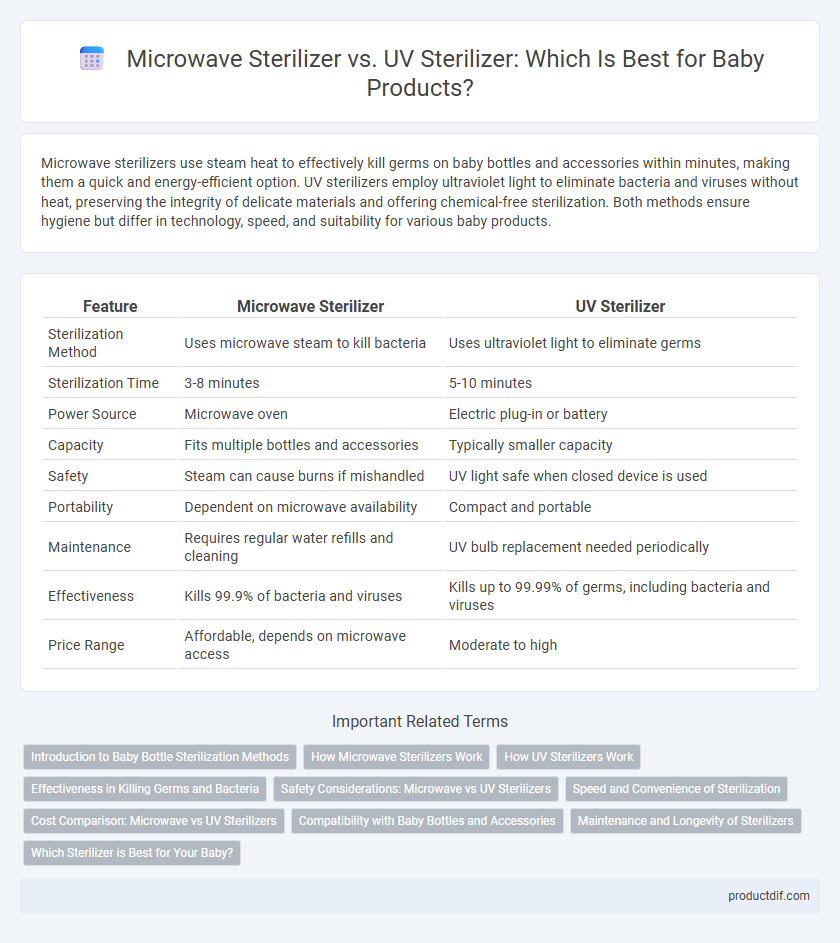Microwave sterilizers use steam heat to effectively kill germs on baby bottles and accessories within minutes, making them a quick and energy-efficient option. UV sterilizers employ ultraviolet light to eliminate bacteria and viruses without heat, preserving the integrity of delicate materials and offering chemical-free sterilization. Both methods ensure hygiene but differ in technology, speed, and suitability for various baby products.
Table of Comparison
| Feature | Microwave Sterilizer | UV Sterilizer |
|---|---|---|
| Sterilization Method | Uses microwave steam to kill bacteria | Uses ultraviolet light to eliminate germs |
| Sterilization Time | 3-8 minutes | 5-10 minutes |
| Power Source | Microwave oven | Electric plug-in or battery |
| Capacity | Fits multiple bottles and accessories | Typically smaller capacity |
| Safety | Steam can cause burns if mishandled | UV light safe when closed device is used |
| Portability | Dependent on microwave availability | Compact and portable |
| Maintenance | Requires regular water refills and cleaning | UV bulb replacement needed periodically |
| Effectiveness | Kills 99.9% of bacteria and viruses | Kills up to 99.99% of germs, including bacteria and viruses |
| Price Range | Affordable, depends on microwave access | Moderate to high |
Introduction to Baby Bottle Sterilization Methods
Baby bottle sterilization methods primarily include microwave sterilizers and UV sterilizers, each designed to eliminate harmful bacteria effectively. Microwave sterilizers use steam generated through microwave energy to sanitize bottles quickly, while UV sterilizers employ ultraviolet light to destroy germs without heat. Both methods enhance baby safety by ensuring bottles are free from contaminants, catering to different parental preferences for speed and sterilization technique.
How Microwave Sterilizers Work
Microwave sterilizers use steam generated by boiling water inside a sealed container to eliminate bacteria, viruses, and germs on baby bottles and accessories. The high temperature steam effectively sterilizes items within minutes, making it a quick and energy-efficient option for busy parents. These devices are compatible with most microwave ovens, offering convenience without the need for chemical sterilizers or electricity-intensive UV lamps.
How UV Sterilizers Work
UV sterilizers use ultraviolet light to eliminate harmful bacteria and viruses on baby bottles and accessories by disrupting their DNA, preventing reproduction and growth. These devices typically expose items to UV-C rays at a wavelength of around 254 nanometers, which effectively penetrates microbial cell walls and inactivates pathogens without the need for heat or chemicals. UV sterilization offers a chemical-free, quick, and energy-efficient method to ensure baby products remain hygienic and safe for use.
Effectiveness in Killing Germs and Bacteria
Microwave sterilizers use high heat generated by microwaves to effectively kill 99.9% of germs and bacteria on baby bottles and accessories within minutes, making them suitable for everyday sterilization. UV sterilizers employ ultraviolet light to destroy the DNA of microorganisms, offering a chemical-free method that is highly effective against bacteria, viruses, and mold spores without heat damage. Both sterilizers provide reliable germ elimination, but UV sterilizers excel in preserving delicate materials, while microwave sterilizers deliver faster sterilization cycles.
Safety Considerations: Microwave vs UV Sterilizers
Microwave sterilizers use steam to eliminate bacteria and viruses, offering effective sterilization but requiring careful attention to appliance power settings to avoid overheating and damage to baby products. UV sterilizers utilize ultraviolet light to disinfect surfaces without heat or moisture, reducing the risk of material degradation while ensuring safe sterilization through timed exposure cycles. Both methods are chemical-free, but parents must consider product compatibility and proper usage instructions to maintain safety and effectiveness in sterilizing baby bottles and accessories.
Speed and Convenience of Sterilization
Microwave sterilizers typically complete the sterilization process within 5 to 10 minutes, offering rapid and convenient use that fits busy parental schedules. UV sterilizers, while slightly longer at around 10 to 15 minutes, provide the added benefit of chemical-free sterilization with minimal heat, preserving baby products' integrity. Both methods enhance sterilization convenience, but microwave options prioritize speed, ideal for quick turnaround times.
Cost Comparison: Microwave vs UV Sterilizers
Microwave sterilizers typically cost between $20 and $50, making them a budget-friendly option for many parents, while UV sterilizers range from $70 to $200, reflecting their advanced technology and effectiveness. The lower initial investment of microwave sterilizers appeals to cost-conscious families, although UV sterilizers offer longer-term value by eliminating bacteria with less water and energy usage. Considering ongoing expenses, UV sterilizers may reduce maintenance costs, but microwave sterilizers remain a practical, economical choice for quick sterilization.
Compatibility with Baby Bottles and Accessories
Microwave sterilizers are compatible with most plastic and glass baby bottles, offering quick sterilization for diverse accessories but require microwave-safe materials to prevent damage. UV sterilizers accommodate a wider range of baby bottles and accessories, including electronic parts, ensuring thorough sterilization without heat exposure or water. Selecting the appropriate sterilizer depends on the specific materials and components of baby bottles and accessories used.
Maintenance and Longevity of Sterilizers
Microwave sterilizers require regular cleaning to prevent buildup of limescale and food residue, which can affect performance over time. UV sterilizers have minimal maintenance needs, typically only requiring occasional wiping of the UV lamps and replacing bulbs every 6 to 12 months for optimal function. The longevity of microwave sterilizers depends on careful use and descaling, while UV sterilizers generally offer longer lifespan due to fewer mechanical parts and consistent sterilization efficiency.
Which Sterilizer is Best for Your Baby?
Microwave sterilizers offer rapid, chemical-free sterilization by using steam heat, effectively eliminating 99.9% of harmful bacteria in minutes, making them ideal for parents seeking quick and affordable options. UV sterilizers use ultraviolet light to penetrate and destroy microorganisms at a cellular level without water, providing a dry sterilization process that preserves the integrity of baby bottles and accessories. Choosing the best sterilizer depends on your lifestyle needs: microwave sterilizers suit fast-paced routines with compatible microwave ovens, while UV sterilizers are perfect for those prioritizing convenience, thorough sterilization, and maintaining product longevity.
Microwave sterilizer vs UV sterilizer Infographic

 productdif.com
productdif.com